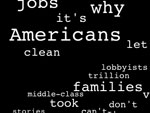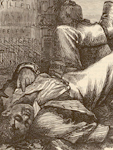State of the Union

Presidents from George Washington to Barack Obama have delivered 214 State of the Union addresses, some delivered orally and many more only written. This website makes the full text of all addresses available and fully searchable, and has done some innovative work text-mining these speeches to examine "changes in the language of the State of the Union address over the past 200 years."
A good place to begin is the website's Essay section, which gives a brief history of the State of the Union address, and describes some of the project's most interesting findings. The website's most prominent feature is a series of graphical representations of the most frequently used words in each address, which allows users to compare those words to those of any other speech.
Another tool allows users to compare the usage of two words in all addresses delivered. Comparing "war" and "peace," for example, reveals that these words have been used in 206 of the addresses, and that the word "war" alone has been used more than 2,600 times, compared to 1,821 usages for "peace."
Ronald Reagan Presidential Foundation and Library

Established by Ronald Reagan, the Reagan Foundation preserves Presidential history and is "dedicated to the promotion of individual liberty, economic opportunity, global democracy, and national pride." Its online presence provides both primary and secondary sources on the life and presidency of Reagan.
Visitors can follow a timeline of Reagan's life in Life and Times, and read five short essays (8001,000 words) on his domestic, foreign, and economic polices, Mikhail Gorbachev, and "Reagan the Man" in The Presidency. Search or browse Reagan's speeches, with both transcripts and video recordings and search or browse quotes drawn from his speaking in Reagan Quotes and Speeches. The entries of his White House Diary from 19811989 may also be browsed, and a separate subsection on Nancy Reagan provides a timeline of her life and brief essays on her relationship with Ronald Reagan and her political causes.
The Reagan Foundation's Archives make only a fraction of their holdings available online. However, visitors can access fast facts on Reagan and his presidency; browse a selection of photos of the President and the First Lady, organized by topic; or search or browse (by month) the Public Papers of President Ronald W. Reagan, which includes statements, speeches, and papers released by the Office of the Press from 19811989.
The Archives' For Educators section includes several document-based lesson plans, as well as curriculum based on current museum exhibits.
Useful for educators looking for both introductory material to Reagan and his presidency and more specific primary sources.
Politics of a Massacre: Discovering Wilmington 1898

On November 10, 1898, Wilmington, NC, experienced what has come to be known as the only coup d'etat in United States history, when white supremacist members of the Democratic Party overthrew the municipal government and killed anywhere between six and 100 African Americans in the city, which at that time had a large, thriving African American population supported by the biracial Republican Party.
This website narrates the history of this event, from the rising racial tensions surrounding the passing of the 14th and 15th Amendments and court disputes over miscegenation and interracial marriage, through the contentious election politics of 1898 that pitted the Democratic Party, supported by white supremacists, against the Republican and Populist Parties that represented African American interests at the local level, and the riot on November 10, through the legacy of the riot in the months and years to come, including the rise of segregationist Jim Crow laws.
Each section is illustrated with links to primary sources, including political cartoons, newspaper clippings, laws, court cases, and photographs of prominent Wilmington African Americans.
The website also includes the 1898 Wilmington Race Riot Report published in 2006 by the North Carolina Department of Cultural Resources' Wilmington Race Riot Commission, which includes maps, photographs, and other primary source materials, and a link to an interactive map allowing visitors to visualize the events of November 10, 1898.